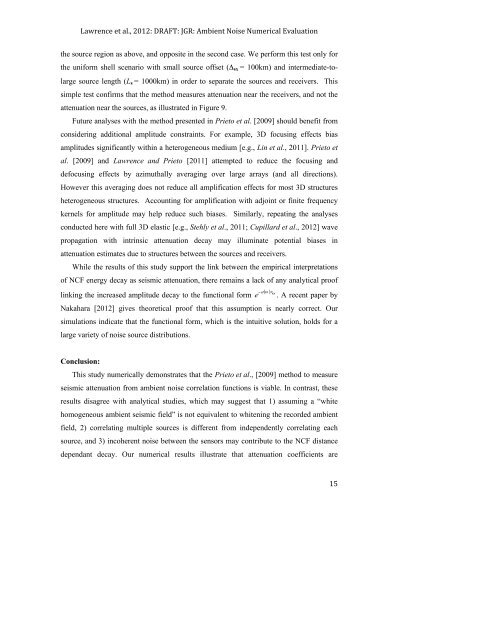Lawrence et al., 2012: DRAFT: JGR: Ambient Noise Numerical ...
Lawrence et al., 2012: DRAFT: JGR: Ambient Noise Numerical ...
Lawrence et al., 2012: DRAFT: JGR: Ambient Noise Numerical ...
You also want an ePaper? Increase the reach of your titles
YUMPU automatically turns print PDFs into web optimized ePapers that Google loves.
<strong>Lawrence</strong> <strong>et</strong> <strong>al</strong>., <strong>2012</strong>: <strong>DRAFT</strong>: <strong>JGR</strong>: <strong>Ambient</strong> <strong>Noise</strong> Numeric<strong>al</strong> Ev<strong>al</strong>uation<br />
the source region as above, and opposite in the second case. We perform this test only for<br />
the uniform shell scenario with sm<strong>al</strong>l source offs<strong>et</strong> (Δsx = 100km) and intermediate-to-<br />
large source length (Ls = 1000km) in order to separate the sources and receivers. This<br />
simple test confirms that the m<strong>et</strong>hod measures attenuation near the receivers, and not the<br />
attenuation near the sources, as illustrated in Figure 9.<br />
Future an<strong>al</strong>yses with the m<strong>et</strong>hod presented in Pri<strong>et</strong>o <strong>et</strong> <strong>al</strong>. [2009] should benefit from<br />
considering addition<strong>al</strong> amplitude constraints. For example, 3D focusing effects bias<br />
amplitudes significantly within a h<strong>et</strong>erogeneous medium [e.g., Lin <strong>et</strong> <strong>al</strong>., 2011]. Pri<strong>et</strong>o <strong>et</strong><br />
<strong>al</strong>. [2009] and <strong>Lawrence</strong> and Pri<strong>et</strong>o [2011] attempted to reduce the focusing and<br />
defocusing effects by azimuth<strong>al</strong>ly averaging over large arrays (and <strong>al</strong>l directions).<br />
However this averaging does not reduce <strong>al</strong>l amplification effects for most 3D structures<br />
h<strong>et</strong>erogeneous structures. Accounting for amplification with adjoint or finite frequency<br />
kernels for amplitude may help reduce such biases. Similarly, repeating the an<strong>al</strong>yses<br />
conducted here with full 3D elastic [e.g., Stehly <strong>et</strong> <strong>al</strong>., 2011; Cupillard <strong>et</strong> <strong>al</strong>., <strong>2012</strong>] wave<br />
propagation with intrinsic attenuation decay may illuminate potenti<strong>al</strong> biases in<br />
attenuation estimates due to structures b<strong>et</strong>ween the sources and receivers.<br />
While the results of this study support the link b<strong>et</strong>ween the empiric<strong>al</strong> interpr<strong>et</strong>ations<br />
of NCF energy decay as seismic attenuation, there remains a lack of any an<strong>al</strong>ytic<strong>al</strong> proof<br />
linking the increased amplitude decay to the function<strong>al</strong> form . A recent paper by<br />
Nakahara [<strong>2012</strong>] gives theor<strong>et</strong>ic<strong>al</strong> proof that this assumption is nearly correct. Our<br />
simulations indicate that the function<strong>al</strong> form, which is the intuitive solution, holds for a<br />
large vari<strong>et</strong>y of noise source distributions.<br />
Conclusion:<br />
This study numeric<strong>al</strong>ly demonstrates that the Pri<strong>et</strong>o <strong>et</strong> <strong>al</strong>., [2009] m<strong>et</strong>hod to measure<br />
seismic attenuation from ambient noise correlation functions is viable. In contrast, these<br />
results disagree with an<strong>al</strong>ytic<strong>al</strong> studies, which may suggest that 1) assuming a “white<br />
homogeneous ambient seismic field” is not equiv<strong>al</strong>ent to whitening the recorded ambient<br />
field, 2) correlating multiple sources is different from independently correlating each<br />
source, and 3) incoherent noise b<strong>et</strong>ween the sensors may contribute to the NCF distance<br />
dependant decay. Our numeric<strong>al</strong> results illustrate that attenuation coefficients are<br />
15
















